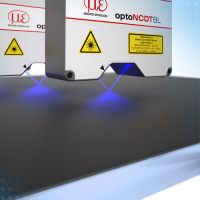
Distance measurement onto anti-reflective coated glass
Anti-reflective coated glass is inspected during the coating process using laser-optical displacement sensors from Micro-Epsilon in order to determine undulations and torsion. The planarity of the coated glass surface is measured in several tracks. Based on the patented Blue Laser Technology, optoNCDT 2300-2DR sensors provide high measurement accuracies on coated glass surfaces. |
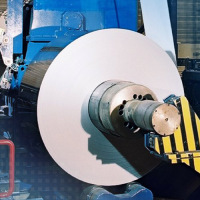
Condition monitoring of bearings
Unscheduled downtime of bearings may induce high costs. Early recognition of bearing damage allows for maintenance labor to be performed during scheduled standstills while minimizing costs. Acceleration sensors from Micro-Epsilon are used for early recognition of bearing damage due to their good signal-to-noise ratio. Measuring both static and dynamic accelerations, they are therefore ideally suited to oscillation measurement of bearings with a very low roller speed (≤ 0.2 Hz). Due to high resolution and temperature stability, the sensors are used in measurement tasks for the oil and gas industry, petrochemicals, power generation plants, mining, steel and cement industries and paper manufacturing. |
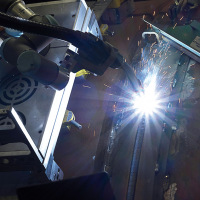
Optimizing weld seams with profile measurements
Inrotech A/S in Denmark relies on sensors from Micro-Epsilon to achieve optimal quality of weld seams in a fully automatic process. The company has developed a welding robot called »Inrotech-Crawler« which calculates welding processes in advance before carrying them out. Therefore, the robot uses the precise measurement values provided by the powerful laser profile scanner from Micro-Epsilon. A scanCONTROL 2900 scanner is fixed on the Inrotech-Crawler and detects the geometry of the seam to be welded before the actual welding process starts. Only these high precision profile measurements enable the process to be automated. Due to its compact, lightweight design with integrated controller, the laser profile scanner is ideally suited to this measurement task. Various connection possibilities offered by the SDK (Software Development Kit) enable the customer to directly transmit the profile data calibrated to their own software via scanCONTROL DLL. The Weldlogic technology from Inrotech then calculates, among other things, the number of welding passes, the position of the weld seams, the weld speed and the oscillation width. Directly after the calculation, the Crawler automatically performs the welding process. |
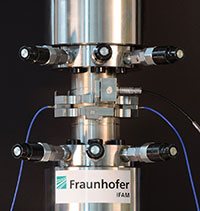
Biaxial inspection of adhesive bonds
The layer thickness of the adhesive bond is typically only a few tenths of a millimeter. The sample is now loaded by tension (axial displacement) and/or torsion. Measuring these very small displacements requires a very accurate and stable measuring system. The test set-up therefore includes three MicroEpsilon capacitive sensors, which are connected via a capaNCDT 6500 capacitive controller with DL6530 demodulator module. Using a special holder, the sensors are attached directly to the tube joining parts of the double tube sample. Two flat sensors with 2 mm measuring range measure the displacement in the axial direction and a cylindrical sensor measures the displacement by torsion. Due to the non-contact measuring technique used, it is easy to decouple axial displacement components and the torsion-induced displacement. |
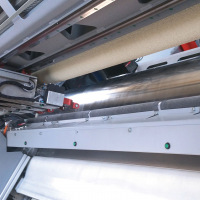
Edge detection of fabric strips in the cutting machine
If the position of the material web is not recognized or is recognized incorrectly, this can result in waste from faulty cutting and machine malfunctions due to missing controller signals. Therefore, the optoCONTROL CLS-K-31 fiber optic sensor from Micro-Epsilon is used for position detection. The sensor reliably detects the beginning of the roll. It is mounted directly on one of the cutting blades and recognizes from a distance of around 140 mm when the fabric is in the cutting position. A switching output (PNP) transmits a signal level directly to the controller and the cutting process begins. In this way, the cutting elements can be positioned exactly to 0.5 to 2 mm depending on the material. After each cut, the fabric position is recalculated. The measuring process is carried out at feed speeds of 20 m/min. The optoCONTROL CLS-K-31 measuring system from Micro-Epsilon provides highly reliable and reproducible measurement results, which ultimately optimizes cutting accuracy, while reducing waste and process disruptions. The CLS-K-31 is even virtually insensitive to scratches and contamination on the shiny metallic surface of the roller. |
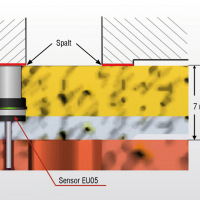
Gap analysis in axial piston pumps
So far, gap measurements inside the pumps were not possible because of the extreme requirements. The sensors must be resistant to high speeds, high pressures up to 1,000 bar and temperatures above 100 °C. Furthermore, the pumps are extremely compact, which significantly limits the space available for integration of sensors. Thanks to the extremely small sensor designs and their high pressure and temperature stability, the eddyNCDT inductive miniature sensors are ideal for this application. The eddyNCDT 3300 eddy current measuring system, which is one of the most powerful systems in the world, is therefore used on the test rig for evaluating the pumps. |
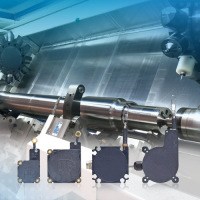
Position measurement of the tailstock
The tailstock is an important part of a lathe or milling machine. The tailstock is used to support long workpieces by means of a center, which catches in the center hole on the front side of the workpiece. In order to detect the center tip, compact draw-wire sensors from Micro-Epsilon are used. The measuring wire is connected to the center tip and measures the displacement of the tailstock. |
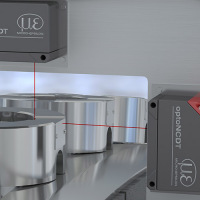
Measuring tool holders in the magazine
Modern machine tools have complex magazines with various tools that are automatically picked up by the machine. In order for these tools to be accurately picked up, the tool holders must be precisely positioned. To check the position of the tool holders, optoNCDT 1420 laser sensors are used, which measure the metallic holders from above and from the side. These smart laser sensors stand out due to their high measuring rates while providing precise measurement values, despite strongly reflecting, metallic surfaces. |
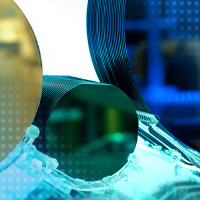
Nanometer positioning in lithography machines
To illuminate individual components on the wafer, the lithographic devices move the wafer to the respective position. Capacitive displacement sensors measure the position of the travel path in order to enable nanometer-accurate positioning. |
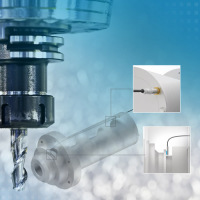
Measuring thermal length expansion of spindles
The SGS 4701 displacement measuring system (Spindle Growth System) is developed specifically for high speed milling machine applications. Due to high machining speeds and the heat generated, the linear thermal expansion of the spindle in the precision machine tool must to be compensated for in order to keep the tool in a defined position at all times. The SGS sensor measures the thermal and centrifugal force expansion of the spindle. These measurement values are fed into the CNC machine tool as correction values, compensating for any positioning errors. The SGS 4701 operates on the eddy current measuring principle. This non-contact measurement method is wear-free. Furthermore, the measurement procedure is resistant to disturbances such as heat, dust and oil. |
